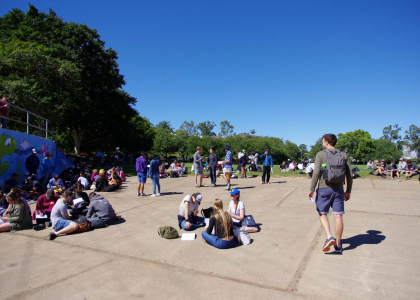Third-year civil engineering students got their hands dirty on a recent field trip, visiting Gold Creek Dam and Norman Creek catchment culvert, experiencing real-world engineering structures and applications across South East Queensland.
The Catchment Hydraulics: Open Channel Flow and Design course is coordinated by Professor Hubert Chanson, a hydraulic engineering and environmental fluid mechanics expert.
The course introduces students to free-surface flows and the design of hydraulic structures. A wide variety of free-surface flows occur in the natural and built environment, ranging from tranquil river flows to flash floods, and from quiet backwaters upstream of weirs to intense turbulence in energy dissipators downstream of spillways and on stepped spillways.
To bring the course content to life, 260 students went on a field trip, first visiting the Gold Creek Reservoir, a storm-waterway system that is home to Gold Creek Dam.
Gold Creek Dam is an embankment dam located in Brookfield, Queensland that was built in 1882 and is now the second oldest large dam in Queensland. Water from the Gold Creek Dam was supplied to Brisbane via gravity main to Kenmore until 1919. In 1928 a tunnel was constructed from Gold Creek to Enoggera Creek and the two reservoirs are now operated as a single connected storage. Despite several extensive refurbishment projects, some of the Dam’s original early 1890s features are still in use.
Students learnt about the dam’s history, from design to the materials used. The Dam’s special characteristics, including its spillway system was also discussed.
Once the primary water supply for the Brisbane region, the reservoir system was built to increase the water supply for Brisbane city, with a maximum spillway capacity of 132 m3/s, though the primary supplier for Brisbane is now Wivenhoe Dam, South East Queensland’s largest water storage facility.
The Norman Creek catchment is one of Brisbane’s most urbanised catchments, designed to harvest urban stormwater, a process involving the capture, treatment, storage and reuse of water from local areas like roads, drains and parks, that would otherwise end up in our drainage system and be released directly into waterways.
At the Norman Creek catchment culvert, students completed activities including measuring the length and width of the floodplain, the inlet/outlet lip as well as the barrel of the culvert, inspecting the cells at its throat and consequently calculating the uniform equilibrium and critical flow depths.
Many students had never before seen a large-scale hydraulic structure, so benefited from time spent in discussion about the capacity and other hydraulic parameters of the structures, completing sketches of the systems, completing on-site measurements and calculation and inspecting structural elements.
On student said, “Not only did we gain exposure to existing hydraulic structures and the chance to apply the fundamental principles learnt in class to solve problems, the trip also gave me the appreciation of these massive hydraulic structures – how they were designed and built, how they are maintained and what they do. The field trip certainly widened my knowledge.”
UQ offers a Bachelor of Engineering with Honours (BE (Hons)), and a Bachelor of Engineering/Master of Engineering (BE (Hons)/ME) with a variety of majors, including civil engineering. The course described here, CIVL3140 is designed for third-year engineering students specialising in civil engineering. Both the BE (Hons) and BE/ME are now accepting mid-year enrolments, commencing in July 2017. Visit www.future-students.uq.edu.au for more information.




